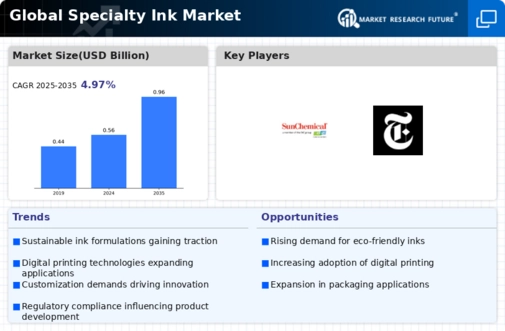Market Trends
Key Emerging Trends in the Specialty Ink Market
The specialty ink market is undergoing notable trends, reflecting a combination of technological advancements, evolving consumer preferences, and diverse applications across industries.
Growth in Digital Printing Technology: A significant trend in the specialty ink market is the increasing adoption of digital printing technology. As digital printing continues to gain prominence in various industries, specialty inks are evolving to meet the specific requirements of digital printing processes. The ability of specialty inks to provide vibrant colors, high resolution, and compatibility with digital printing equipment is contributing to their expanded use in the market.
Rising Demand for Water-Based Specialty Inks: There is a growing preference for water-based specialty inks, driven by environmental considerations and regulatory compliance. As sustainability becomes a key focus for industries, water-based inks are gaining popularity due to their lower levels of volatile organic compounds (VOCs) and reduced environmental impact. The demand for eco-friendly printing solutions is influencing the formulation and adoption of water-based specialty inks.
Expanding Applications in Packaging Industry: The packaging industry is a major contributor to the demand for specialty inks. With the increasing importance of product differentiation and branding, there is a rising demand for inks that can deliver unique visual effects and enhanced print quality. Specialty inks, including metallic, fluorescent, and thermochromic inks, find applications in packaging to create eye-catching designs and improve shelf appeal.
Innovation in UV-Curable Specialty Inks: UV-curable specialty inks are witnessing innovations to enhance their performance characteristics. These inks, cured instantly by exposure to ultraviolet light, are known for their quick drying, durability, and ability to print on various substrates. Advancements in UV-curable specialty inks are addressing industry demands for faster production speeds and improved print quality.
Customization and Personalization in Printing: The demand for customization and personalization in printing is driving the adoption of specialty inks. Industries such as textiles, apparel, and promotional products are leveraging specialty inks to create unique designs, textures, and effects. The ability of specialty inks to enable personalization contributes to their increasing use in applications where individualized prints are valued.
Technological Advancements in Conductive Inks: Conductive inks, a subset of specialty inks, are experiencing advancements to meet the requirements of emerging technologies. Innovations in the formulation of conductive inks are facilitating their use in flexible and printed electronics, including sensors, RFID tags, and smart packaging. The growing interest in wearable technology and the Internet of Things (IoT) is propelling the demand for specialized conductive inks.
Global Market Dynamics: The specialty ink market is influenced by global dynamics, including trade relationships, supply chain disruptions, and regional demand variations. Changes in raw material prices and geopolitical factors can impact the overall market dynamics, influencing trends and pricing structures.
Adoption of Specialty Inks in 3D Printing: The expanding use of 3D printing technology is driving the adoption of specialty inks for additive manufacturing processes. Specialty inks with specific properties, such as conductivity, flexibility, or bio-compatibility, are developed for use in 3D printing applications across industries, including healthcare, aerospace, and automotive.
Focus on Sustainable and Bio-Based Inks: Sustainability is a key trend influencing the specialty ink market, with a growing focus on bio-based and sustainable ink formulations. Manufacturers are exploring alternative raw materials and production processes to reduce the environmental impact of specialty inks. Bio-based inks, derived from renewable resources, align with the broader industry trend towards eco-friendly solutions.
Custom Ink Solutions for Branding: Collaboration between specialty ink manufacturers and brands for custom ink solutions is becoming more prevalent. This collaborative approach allows brands to create unique and recognizable prints, contributing to brand identity. Tailored ink formulations enable brands to differentiate their products in the market, fostering a trend towards customized printing solutions.






Leave a Comment